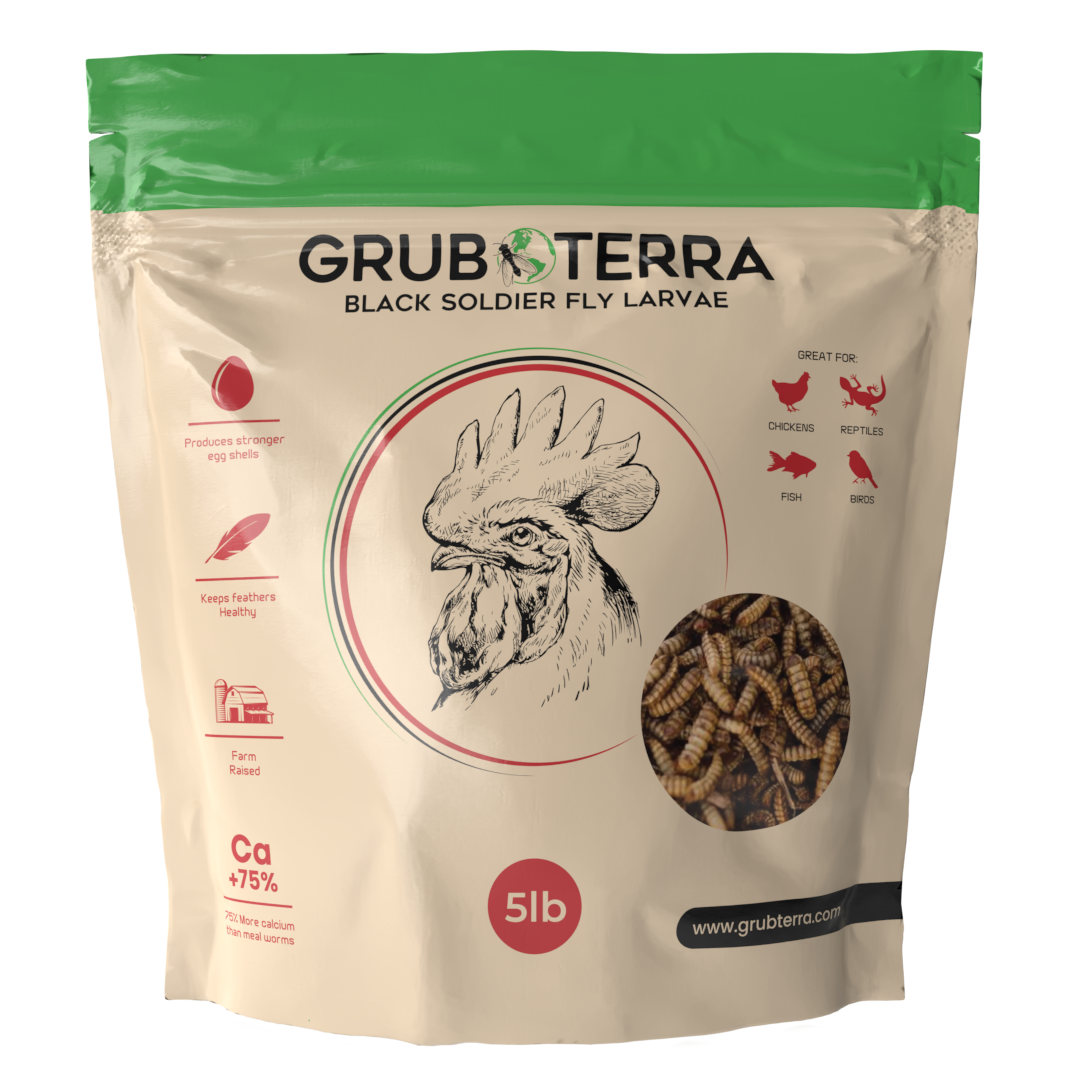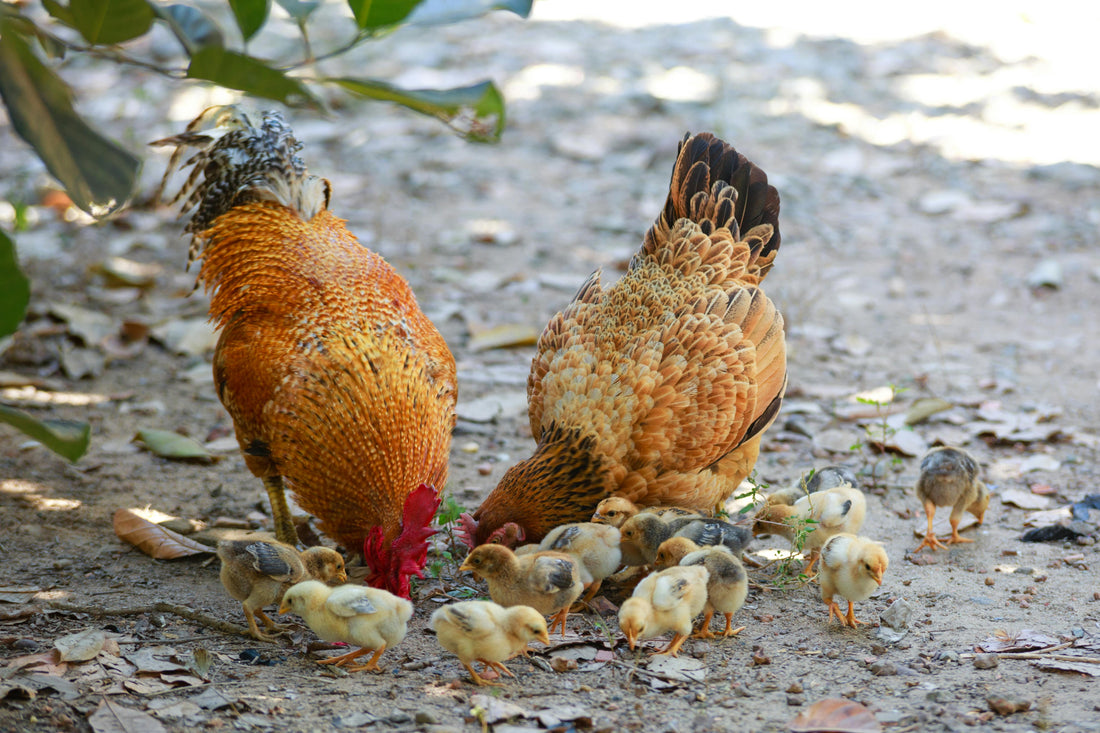Understanding the Basics
Choosing the Right Breed
The choice of chicken breed impacts everything from egg production to adaptability to your local climate. To help you make the best choice, Grubterra offers insights into selecting the right breed for your needs.
Preparing Your Space
Creating a safe, warm environment for your chicks is crucial. Your brooder setup should include a reliable heat source and comfortable bedding. For tips on creating the ideal brooder environment, visit Grubterra.

The First Few Days
Setting Up a Brooder
A well-set-up brooder provides warmth and security, mimicking the conditions under a mother hen. Maintaining the right temperature and humidity is crucial for the well-being of your chicks. Learn more about brooder setup and maintenance at Grubterra.
Feeding Your Chicks

Types of Feed
Starting with a high-quality chick starter feed is essential for your chicks' growth. As they grow, their dietary needs will change. Incorporating Grubterra’s Black Soldier Fly Larvae into their diet provides a nutritious boost. Discover more feeding tips and products at Grubterra.
Watering Your Chicks
Ensuring your chicks have access to clean, fresh water is vital. The right watering system helps keep your chicks hydrated and healthy. For advice on selecting and maintaining chick watering systems, check out Grubterra.
By following this guide and utilizing resources from Grubterra, you’ll be well-equipped to raise healthy, happy chicks. Whether you're a first-time chicken keeper or looking to refine your chick-raising practices, Grubterra provides the products and insights you need for success.
Monitoring Chick Health
Common Health Issues
Keeping an eye on your chicks for any signs of distress or illness is vital. Symptoms like lethargy, lack of appetite, or abnormal droppings can indicate health problems. Early detection and treatment are crucial for the well-being of your flock. For detailed guidance on monitoring and maintaining chick health, visit Grubterra.
Preventive Measures
Maintaining a clean brooder, providing a balanced diet, and ensuring regular health checks are key preventive measures against common health issues in chicks. Vaccinations may also be necessary depending on the diseases common in your area. For more information on keeping your chicks healthy and preventing diseases, explore the resources available at Grubterra.
Growth Stages of Chicks

As chicks grow, their needs change. Understanding these growth stages is crucial for providing appropriate care at each phase of development.
From Chicks to Pullets
Transitioning from chicks to pullets involves changes in diet, space, and socialization needs. This stage is critical as they develop into laying hens or mature roosters. For insights on navigating the growth stages of your chicks, Grubterra offers a wealth of information and advice.
Introducing to the Flock
Integrating new birds into your existing flock requires careful planning and supervision to ensure harmony and prevent bullying. Start with brief, supervised interactions and gradually increase their time together. For best practices on introducing new chickens to your flock, consult the expert advice on Grubterra.
Transitioning to the Outdoors
Acclimatizing Your Chicks
Gradually exposing your chicks to the outside environment is essential for their adaptation to outdoor life. This process should be done carefully to avoid stress and ensure their safety. For tips on acclimatizing your chicks to the outdoors, including when to start and how to do it safely, visit Grubterra.
Outdoor Housing
Ensuring your outdoor coop and run are ready for your growing chicks is crucial. Adequate space, protection from predators, and access to food and water are essential components of a suitable outdoor environment. For guidance on preparing your outdoor space for your chicks, Grubterra provides detailed advice and solutions.
FAQs
What is the best way to keep the brooder clean?
To keep the brooder clean, perform daily checks and remove any wet or soiled bedding. Weekly, thoroughly clean and disinfect the brooder, replacing all bedding and ensuring the area is dry before returning the chicks.
How can I tell if my chicks are too hot or too cold?
Chicks that are too cold will huddle together under the heat source, while those that are too hot will spread out as far away from the heat as possible and may pant. Adjust the heat source accordingly to ensure their comfort.
When can chicks start eating treats?
Chicks can start having treats, such as small bits of fruits and vegetables, from about 2 weeks old. However, treats should not make up more than 10% of their diet, and always provide grit to help them digest these new foods.
How do I introduce my chicks to the older chickens?
Begin by allowing the older chickens to see but not touch the chicks, using a wire barrier for separation. After a few weeks, allow supervised interactions in a neutral area until you observe that they can coexist peacefully before permanently housing them together.
What should I do if a chick seems sick?
Isolate the sick chick immediately to prevent the spread of potential illness. Provide supportive care, such as ensuring it stays warm and has access to water and food. Consult a veterinarian for a proper diagnosis and treatment plan.
Can chicks be raised indoors?
Chicks can be started indoors in a brooder for the first few weeks of life. However, as they grow and develop, they will need more space and eventually should be transitioned to an outdoor coop to accommodate their natural behaviors and need for fresh air and sunlight.
As you embark on this chick-raising journey, it's beneficial to arm yourself with as much knowledge as possible. For a comprehensive list of what you'll need—and might want—to raise chicks for eggs, the guide provided by Oak Abode offers invaluable insights. From essential equipment to helpful extras, their recommendations can help ensure you're well-prepared for the rewarding task ahead. Check out their extensive guide here to complement your chick care efforts with expert advice and practical tips.
Conclusion
Raising baby chicks is a fulfilling endeavor that requires attention, care, and a bit of knowledge. By following the guidelines outlined in this guide, from setting up a proper brooder to introducing them to the outdoors, you'll be well on your way to nurturing a healthy, vibrant flock. Remember, the key to successful chick rearing is preparation, observation, and a willingness to learn from the process. Happy chick raising!
Incorporating insights from Grubterra, especially their products like the Grubterra 5lb Black Soldier Fly Larvae, can significantly contribute to the nutritional needs of your growing chicks. For more in-depth articles and resources on chick care, visit Grubterra's blog.
Remember, each chick is an opportunity to foster life and contribute to sustainable living practices. With patience and care, you'll witness the delightful journey of your chicks growing into healthy, productive chickens that are integral to your homesteading or backyard farming efforts.


